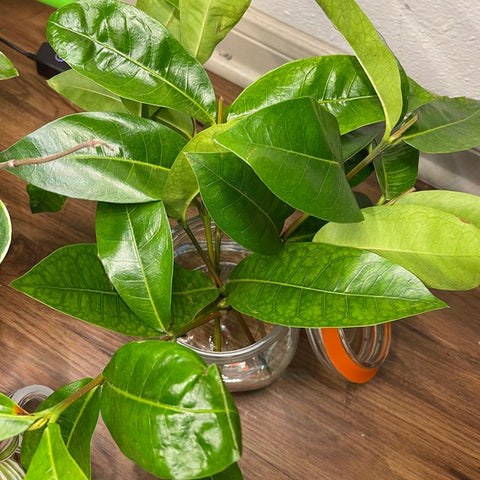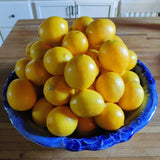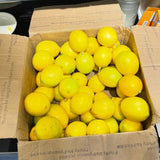Grow Your Own large, fragrant Meyer Lemon Trees From Seeds
When life gives you lemons, grow a tree! We have easy step-by-step instructions to start your own fragrant fruit-bearing tree indoors.
Meyer Lemon flowers are white with a purple base and fragrant. The fruit is rounder than a true lemon, deep yellow with a slight orange tint when ripe, and has a sweeter, less acidic flavor. The lemons contain a highly acidic pH of between 2 and 3. This acidity level allows for these lemons to be used as antibacterial and antiseptic cleaners.
During the winter months, these abundant fruit trees can grow indoors and will produce beautiful blooms that will make the house fragrant.
Our naturally grown meyer lemon seeds allow you to grow your own fruit trees, indoor or outdoor. Lemon trees are vigorous fruit producers and a single seed has the potential of yielding thousands of lemons. While these lemon trees produce fruit throughout the year, the majority of the crop is harvest-ready in the fall and winter.
Lemon trees can be grown on balconies, patios, and limited-space gardens. Enjoy the attractive trees and the scent of indoor winter blossoms if you choose to plant your citrus trees in an indoor container. Many people grow these lemon trees as ornamentals because the small trees are attractive even if they do not have fruit.
Packet contains 5 seeds hand-packed with care.
Packed in 3 x 4 inch sealable labeled bag
How To Grow A Lemon Tree From Seeds
----------------------------------
Here's how you grow your own lemon tree
Firstly you'll need
An organic lemon since non-organic lemons often contain non-germinating seeds
Fertile potting soil, and natural fertilizers like compost
A seedling pot that is about 24 inches wide by 12 inches deep
A planting pot that is six inches wide and six inches deep (this comes in handy further down the track)
A sunny, indoor growing location
Moisten the potting soil so that it is damp, but not soaked, all the way through.
Fill the smaller pot with soil, all the way up to an inch below the rim.
Cut open your lemon and remove a seed. Remove all of the pulp from its surface. A good way to do this is to simply suck on it until it is clean.
Do not delay to plant. The seed must still be moist when it is buried into the soil in the smaller pot. Plant the seed about half an inch deep in the middle of the pot.
Spray the soil that is directly above the seed gently with water from a spray bottle.
Cover the pot with clear plastic wrap, seal the edges with a good rubber band, and poke small holes in the top with a pencil.
Place the pot in a warm, sunny location.
Spray on more water occasionally, not allowing the soil to dry out. Do not cause water to puddle though. Just keep the soil somewhat moist.
After about two weeks, when the sprouting emerges, take the plastic covering off. If you need additional light for your lemon plant, you can use a grow light to supplement the sun's light.
Take care of the young plant by keeping the soil damp, by making sure it gets at least eight full hours of light per day, and by giving it moderate doses of organic fertilizer like compost.
Watch over your plant to ensure it is not attacked by bugs or diseases. Prune off brown, dead leaves when necessary.
When the plant outgrows its small pot, put it in the larger pot. You will go through much the same procedure when you re-plant it as when you first planted it. Younger plants need more water than older plants, but they all do need adequate water. Don't starve your poor plant after all that work of growing it!
When life gives you lemons, grow a tree! We have easy step-by-step instructions to start your own fragrant fruit-bearing tree indoors.
Meyer Lemon flowers are white with a purple base and fragrant. The fruit is rounder than a true lemon, deep yellow with a slight orange tint when ripe, and has a sweeter, less acidic flavor. The lemons contain a highly acidic pH of between 2 and 3. This acidity level allows for these lemons to be used as antibacterial and antiseptic cleaners.
During the winter months, these abundant fruit trees can grow indoors and will produce beautiful blooms that will make the house fragrant.
Our naturally grown meyer lemon seeds allow you to grow your own fruit trees, indoor or outdoor. Lemon trees are vigorous fruit producers and a single seed has the potential of yielding thousands of lemons. While these lemon trees produce fruit throughout the year, the majority of the crop is harvest-ready in the fall and winter.
Lemon trees can be grown on balconies, patios, and limited-space gardens. Enjoy the attractive trees and the scent of indoor winter blossoms if you choose to plant your citrus trees in an indoor container. Many people grow these lemon trees as ornamentals because the small trees are attractive even if they do not have fruit.
Packet contains 5 seeds hand-packed with care.
Packed in 3 x 4 inch sealable labeled bag
How To Grow A Lemon Tree From Seeds
----------------------------------
Here's how you grow your own lemon tree
Firstly you'll need
An organic lemon since non-organic lemons often contain non-germinating seeds
Fertile potting soil, and natural fertilizers like compost
A seedling pot that is about 24 inches wide by 12 inches deep
A planting pot that is six inches wide and six inches deep (this comes in handy further down the track)
A sunny, indoor growing location
Moisten the potting soil so that it is damp, but not soaked, all the way through.
Fill the smaller pot with soil, all the way up to an inch below the rim.
Cut open your lemon and remove a seed. Remove all of the pulp from its surface. A good way to do this is to simply suck on it until it is clean.
Do not delay to plant. The seed must still be moist when it is buried into the soil in the smaller pot. Plant the seed about half an inch deep in the middle of the pot.
Spray the soil that is directly above the seed gently with water from a spray bottle.
Cover the pot with clear plastic wrap, seal the edges with a good rubber band, and poke small holes in the top with a pencil.
Place the pot in a warm, sunny location.
Spray on more water occasionally, not allowing the soil to dry out. Do not cause water to puddle though. Just keep the soil somewhat moist.
After about two weeks, when the sprouting emerges, take the plastic covering off. If you need additional light for your lemon plant, you can use a grow light to supplement the sun's light.
Take care of the young plant by keeping the soil damp, by making sure it gets at least eight full hours of light per day, and by giving it moderate doses of organic fertilizer like compost.
Watch over your plant to ensure it is not attacked by bugs or diseases. Prune off brown, dead leaves when necessary.
When the plant outgrows its small pot, put it in the larger pot. You will go through much the same procedure when you re-plant it as when you first planted it. Younger plants need more water than older plants, but they all do need adequate water. Don't starve your poor plant after all that work of growing it!







